steering wheel VOLKSWAGEN JETTA 2008 Owners Manual
[x] Cancel search | Manufacturer: VOLKSWAGEN, Model Year: 2008, Model line: JETTA, Model: VOLKSWAGEN JETTA 2008Pages: 477, PDF Size: 77.6 MB
Page 8 of 477

Daytim e dri ving light s 3.1: 46
D eac tivating th e sw itcha ble locking feature
2. 1: 63
Di ese l engi ne
Adding eng ine oil 3.2: 41
C ha nging engin e oil 3.2: 41
E ngin e oil 3.2: 4 1
E ngi ne oil sp ecifica tions 3.2: 37
Die sel ru el 3.2: 33
W int er operation 3.2: 33
Differential lock 3.2: 4
Di gital clock 3.1:
5
Display 3.1: 7, 12
Display s
O ne-co lor display 3.1 : 12
Distance between driver and steering wheel
2.1: 4
tra velled 3.1: 9
Door re le a se hand le 3. 1: 3
Do ors
Wa rnin g light 3.1: 26
Drain the ba tt ery 3 .1: 52
Driving economically 3.2 : 14
Dr iv in g o utside or the U. S.A . or Ca nada
Pr eca utio n s 3.2: 91
Driving sa re ty 2.1: 3
Drivi ng time 3.1: 9
Drivi ng w ith an aut oma tic tra nsmi ssion 3.1:
9 9
Driving with children 2.1: 51
Driv ing with respe ct
th e e nvironment 3.2:
14
Du st filter 3.1: 88
E
EDL3.2: 4
ED S
Warning ligh t 3. 1: 27
E lec tri c sea l adj ustm ent
See Sea t adjustm ent
El ec tr ica l accesso ries 3.1: 73
Book let 0.1 General Index ®
Elec trolyte level
C heck ing 3.2: 50
E lectro-mec hanical power steering syste m
Warn ing ligh t 3 .
l: 29
E le ctro nic Differen tia l Lo ck
Warning ligh t 3.1: 27
E lec troni c different ial lock 3.2: 4
E lec tronic immobilizer 3.1: 94
Warn ing light 3.1:
23
E lectro nic parking assistance 3.1: 106
E lectro nic Powe r C ontro l (EP C)
Warning light 3.1: 23
E lec tron ic S ta bili zation Program (E S P)
H ow it wo rks 3.2: 5
E lec tro nic S tabiliz ation Program 3.1 : 28, 9 1
Wa rnin g light 3.1: 28
E m erge ncy flashe r 3.1: 48
E m erge ncy wa rning ligh ts
Warn ing light 3.1: 24
E ng in e
Br ea k-in 3.2: 7
E ngine compartm ent
C leaning 3.2: 22
Pre cauti ons y ou shou ld take w hen work
ing inside the en gin e compa rtment 3.2 :
34
Wo rki ng in the en gine compartm ent 3.2:
34
Engi ne cool ant 3.2 : 43
A dditive s 3. 2: 43
C an
I add plain water to th e en gin e coo l
ant? 3.2 : 44
C oolant lo sses 3.2: 45
E n gi ne
Wa rnin g lig h t 3.1: 23
E n gine hood
Warning light 3.1: 26
Engine hood 3.2: 36
1 low do
! unlock the en gi ne ho od ? 3 .2: 36
E n gine
Wa rning lig ht 3. 1: 23
Engine management
Wa rnin g light 3.1: 23
Alphab etical index 5
Page 127 of 477
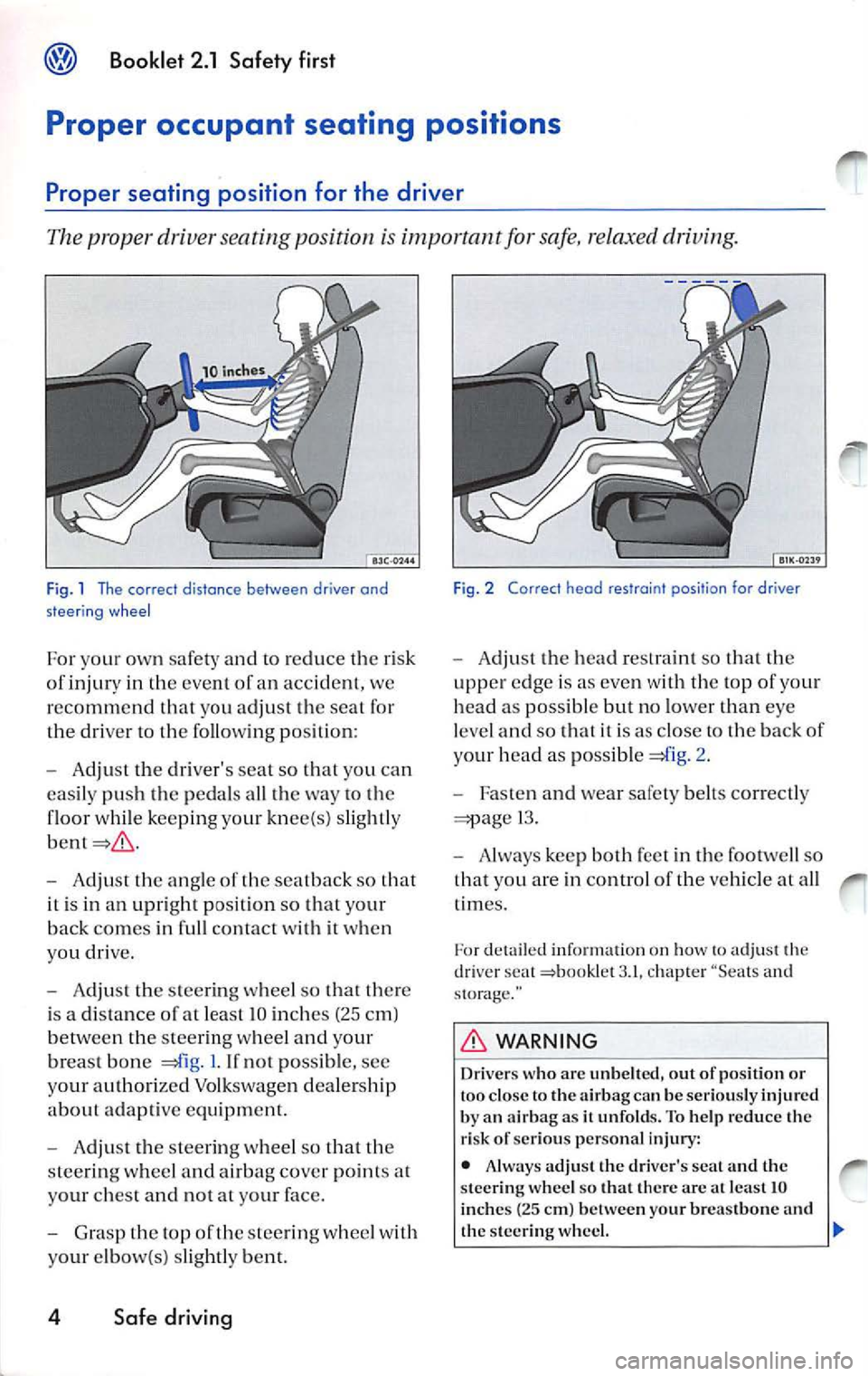
Booklet 2.1 Safety first
Proper occupant seating positions
Proper seating position for the driver
The proper driver seating position is important for safe, relaxed driving.
Fi g. 1 The correct distance between driver and
steering wheel
For yo ur own safety and Lo reduce the risk
of injur y in th e eve nt of a n accid ent, we
recommend that y ou adju st th e se al
the dri ver to the fo llowi ng po sition:
- A djust th e dri ver's se at so that you can
eas ily push the pedal s all th e way
10 th e
floor while k eeping you r kn ec(s) s light ly
- Adj ust the a ngl e of the sea t b ac k so that
it i s in an upri ght p osition so that your
back comes in full contact with it when
yo u dri ve.
- Adjust th e stee rin g w hee l so that there
i s a di sta nce of at le a st 10 in ch es (25 cm)
b etween the s tee rin g w hee l and your
breast bone
1. I f n ot possib le, see
yo ur authori zed Volkswagen dealership
about adapti ve equipm ent.
- Adju st th e steerin g w hee l so that the
s tee ring whee l a nd airbag cove r point s at
y our ch es t and not at your fa ce.
- Grasp the top of the ste erin g wheel with
yo ur clbow(s) sli ghtl y be nt.
4 Safe driving
Fig. 2 Correct head restraint position for driver
- Adjust t he hea d r estra int so that the
upper edge is as eve n with the to p of your
h ea d as possibl e but n o lower than eye
l eve l and so that it i s as close
to th e ba ck of
yo ur head as possible
2.
- Faste n and wear safe ty belt s co rrectl y
13 .
- Always keep both feet in the footwe ll so
that you are in control of th e ve hicle at all
tim es.
For detail ed in format io n on h ow 10 adj ust drive r 3.1, c hap te r "Sea ts an d
s torage ."
WARNING
Drivers who arc unb elted , o ut of position or
too clo se to the airbag can be seriously injured
b y an airbag as
it unfold s. To help reduc e th e
ri sk of serious p ers onal injury:
• Always adju st
driv er's scat and the
s te ering whe el so that there are al least 10
inches (25 cm) between your brea stbone and
the steer ing wheel.
Page 139 of 477
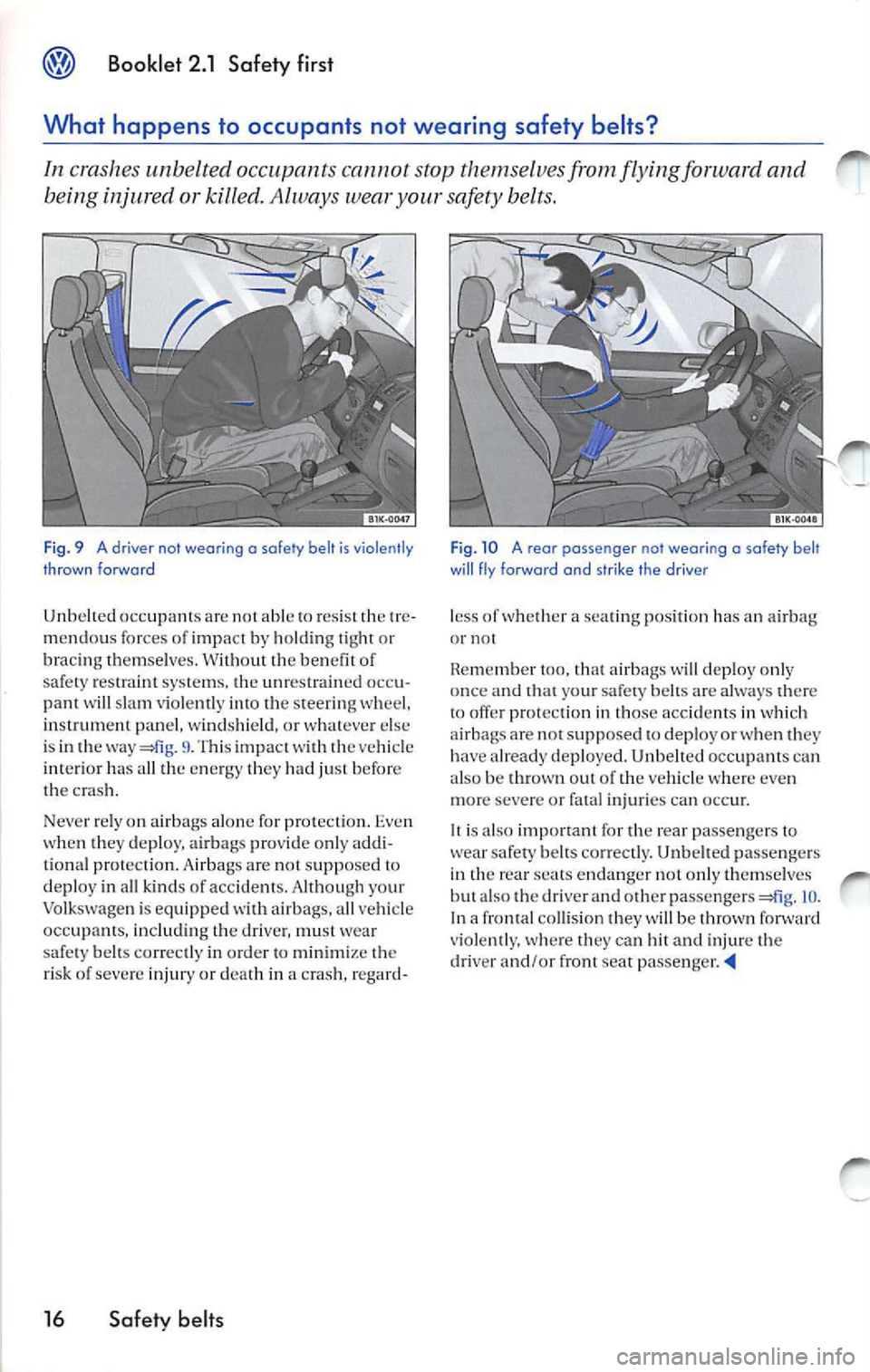
Booklet 2.1 Safety first
What happens to occupants not wearing safety belts?
In crashes unbelted occupant s cannot stop themselve s from flying forward and
being injured or killed. Always wear your safety belts.
Fig. 9 A driver not wearing o safety belt is violently
thrown forward
Un belted occ upants ar e not abl e to res ist the tre
m endo us fo rces o f imp act by holdin g tig ht or
bra cing themse lves . W ith ou t th e ben efit of
s af etv res traint systems. th e unr estrai ned o ccu
slam vio le ntl y into t he steering wheel,
in strnm ent panel, win dshi eld , o r w hate ve r else
is in the way
9. T his impac t w ith the ve hicle
inte rior has a ll th e e nergy the y had just before
the cras h.
Neve r re ly on airb ags alone for pro tec tion. Eve n
wh en th ey deplo y, air ba gs provide onl y a ddi
t io n al prot ection. Airb ags are not su pposed
depl oy in all kin ds of a cci den ts. Alt hough your
Volk swag en i s eq uipped with airbags, all vehicl e
occ upant s, inclu ding th e dr ive r, mu st wear
sa fety belt s co rrectl y in order to min imize th e
ri sk of seve re injur y or d eath in a cras h, regard-
16 Safety belts
Fig . 10 A rear passenger not wearing o sa fety belt
will fly forward and strike the drive r
less of wheth er a se atin g pos ition has a n or no t
R em emb er too, that ai rbags w ill dep loy o nly
once a nd t hat your sa fery be lts are always there
to offe r pro tec tion in th ose acci dent s in whi ch
a irba gs are not supp osed to dep loy o r w hen they
h ave already deployed. Unbelt ed occ upan ts can
a lso be thro wn out of th e ve hicle w here e ven
more severe or fa ta l in jur ies can occur.
I t i s a lso important for the rear passe ngers to
wea r sa fety belts correct ly. Unb elt ed pas se nge rs
in th e re ar sea ts endanger no t on ly th emse lves
b u t a ls o th e driver an d oth er pa ssenge rs
JO .
In a fron tal collisio n th ey w ill be thrown forward
v io len tly, whe re they ca n hi t a nd injure the
driver and /or front seat
Page 207 of 477
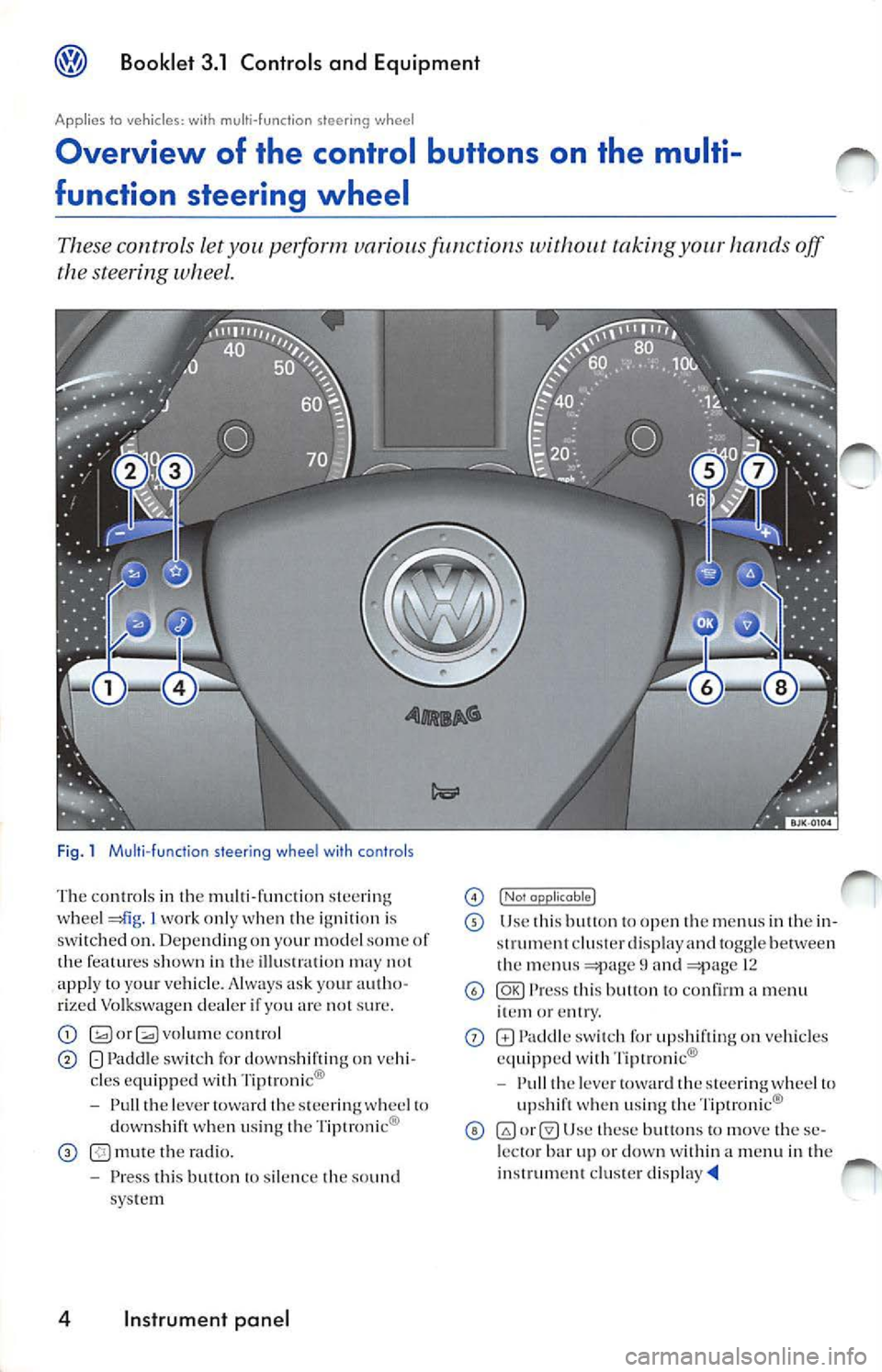
Booklet 3.1 Controls and Equipment
Applies to vehicl es, with multi-fun cti on s teeri ng wheel
Overview of the control buttons on the multi
function steering wheel
These controls let you pe,form variou s fu 11ctions without tak ing off
the steering wheel.
Fig . 1 Mu lti-fu nct io n steer ing whee l wi th co ntrols
T he con tro ls in th e multi -fun ction ste erin g
whee l I work only when ignition is
sw itch ed on . Depend ing on yo ur model some of
features shown in the may 1101 app ly to your vehicle. A lways ask you r auth o
rized Volkswag en dea ler if yo u not sur e.
G;;l orQ volume con tro l
Pad dle sw itch for downshiftin g on vehi
cles equipped with Tip tronic®
- Pull th e lever towa rd
s tee ring whee l to
down shift when u sin g Tiptronic ®
mute th e rad io .
- Pre ss thi s butt on to silenc e
sound
sys te m
4 Instrument panel
I Nol J
Use thi s to open m enu s in th e in
st rum ent cluster disp lay and togg le betwe en
menu s and 12
Press co nfirm a menu or
on vehicles
e quipp ed wi th Tipl ronic®
- Pull
leve r stee ring wh eel to
up shi ft w hen u sing the Tiptroni c®
U se these bu11on s to m ove these
l ec tor bar up or dow n within menu in the
i nst rum ent clu ste r
Page 216 of 477
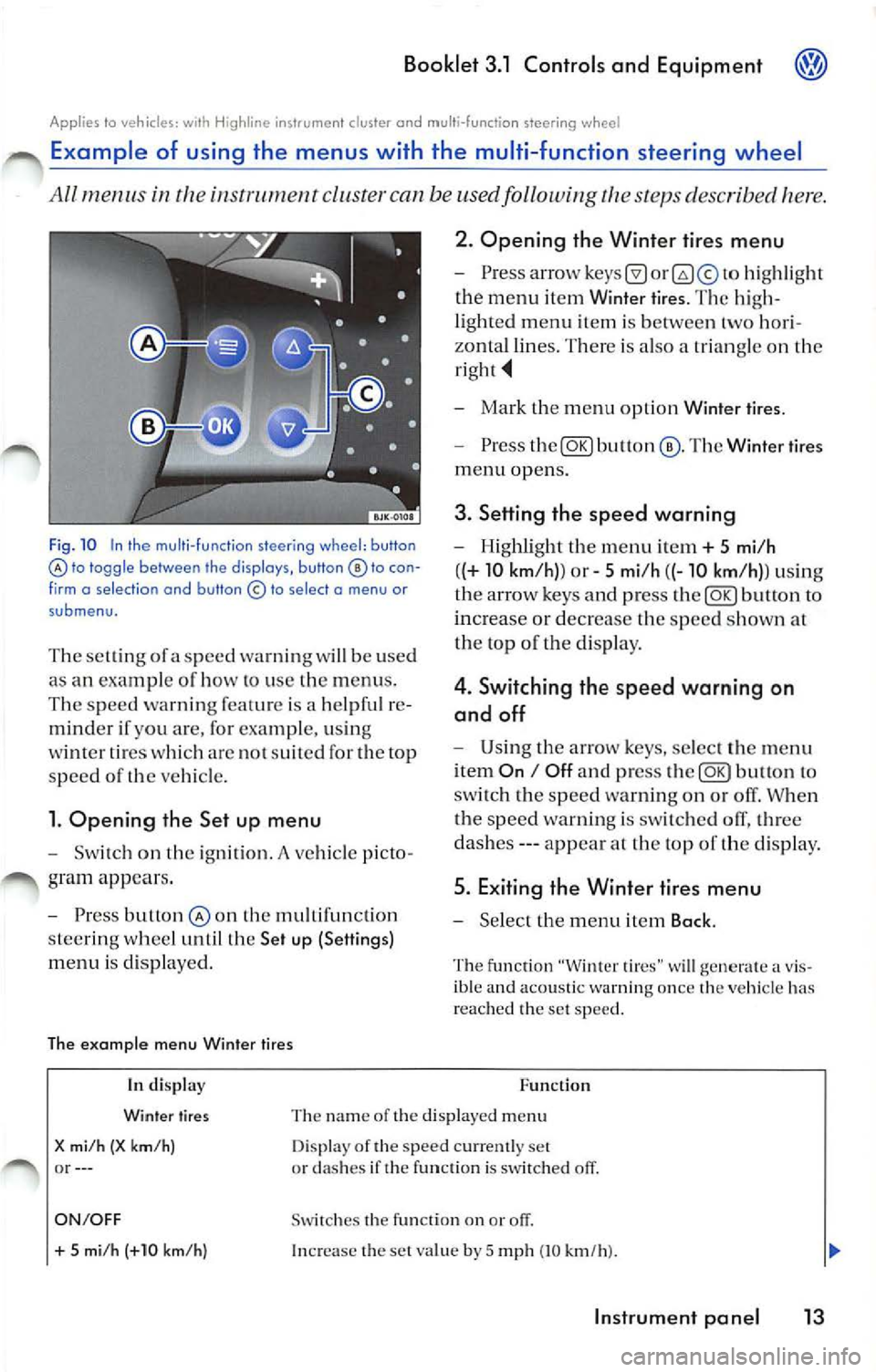
Booklet 3.1 Controls and Equipment
Applies to vehicles: H ighline instrumen t cluster and multi-function steering wheel
Example of using the menus with the mult i- function steering wheel
All menus in the i nstrwnen t cluster can be used following the steps described here.
Fig . 10 In the multi -fu nction steering wh eel: button lo toggle between the disp lays, button to con
f irm o se lect ion and button © to select o menu or
submenu.
T he se lling of a speed warning w ill be used
as an exam pie of how lo use the menus .
The speed warn ing feat ure is a helpfu l re
minder if you are, for example, usi ng
wi nter ti res whi ch arc no t suit ed for th e top
s p ee d of
ve hicle.
l. Opening the Set up menu
Switch on the ignition. A ve hicle p icto
gram appea rs .
Press butlon the mult ifunct io n
s tee rin g whee l until the Set up (Settings)
menu is disp layed.
The example menu Winter tires 2. Opening the Winter
tires menu
hig hli ght
the menu item Winier tires. The hig h
li ghted menu item is between two hori
zonta l lines. Th ere is also a trian gle on the
Mark the m enu opt ion Wint er tire s.
Press The Winter tires
menu opens.
3. Setting th e speed warning
Highlight th e menu it em+ 5 mi/h
( (+
10 km /h )) or 5 mi /h ((-10 km /h)) usi ng
th e ar row keys and p ress
butto n to
increa se or decrease the speed s how n at
th e top of t he di sp lay.
4 . Switching the speed warning on
and off
U sing th e arrow keys , select th e menu
i tem
On I Off a nd press to
sw itch the sp ee d wa rnin g on o r off. When
t h e s peed warnin g is swi tched olT, three
da she s --- appea r at the top of the disp lay .
5. Exiting the Winter tires menu
Se lect the m enu item Back .
The fu nction "Winter tires" w ill generate a v is
ible and acoustic warn ing once the ve hicl e has
r eac hed th e set speed .
In di splay
Winter tires
X mi /h (X km/ h) or--- Function
Th e na m e of the displaye d m enu
D isp lay of the speed cur ren tly set
or dashes if the function is switched off.
ON/OFF Swi tc h es the fu nction on or
+ 5 mi /h (+10 km/h ) In crease the set va lue by 5 mp h (10 km/h ).
Instrument pan el 13
Page 293 of 477
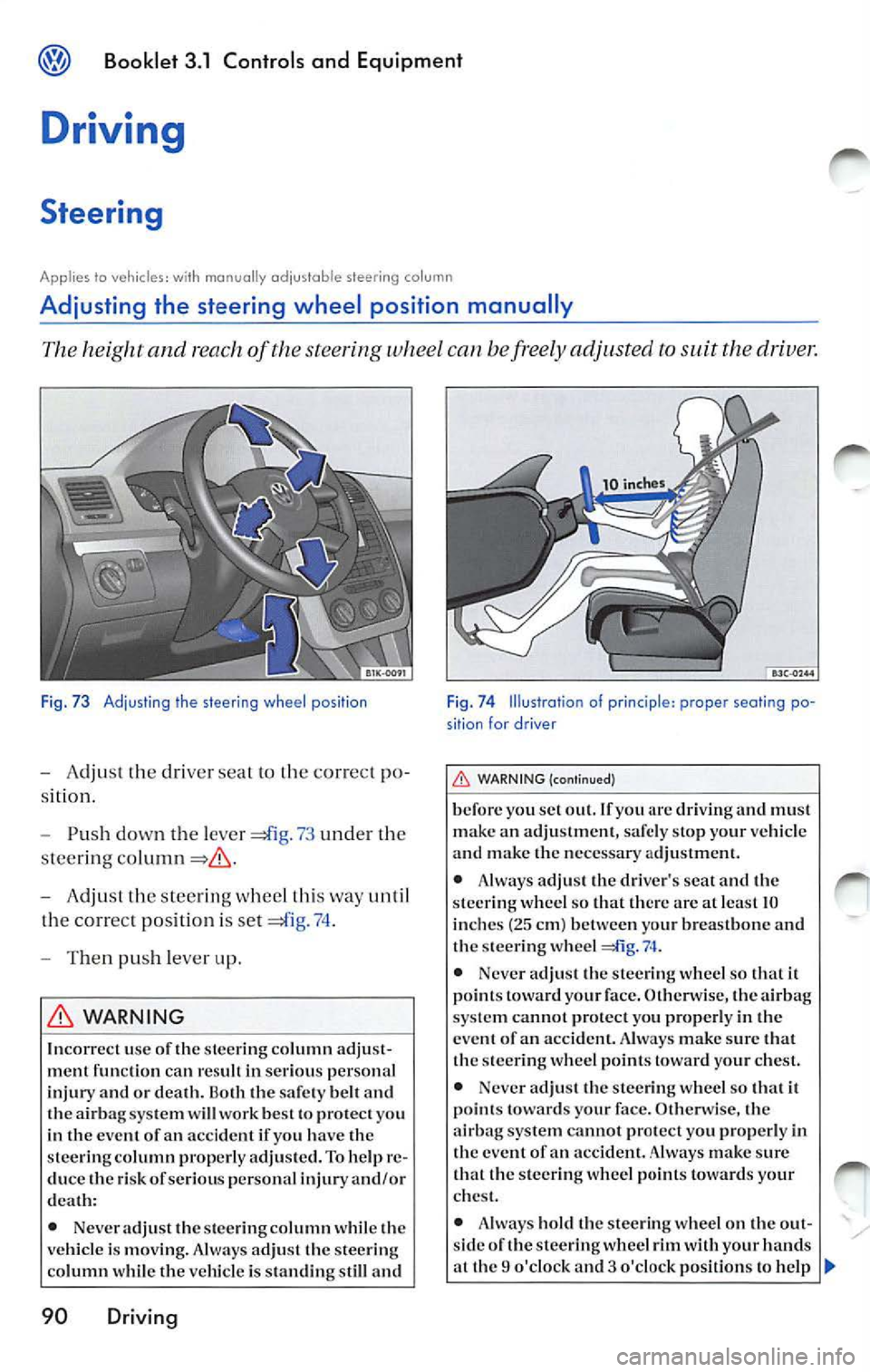
Booklet 3.1 Controls and Equipment
Driving
Steering
Applies lo vehicles: with manually adju stab le steering column
Adjusting the steering wheel position manually
The and reach of the steering whe el can be freely adjusted to suit the driver.
Fi g. 73 Adjusting the stee ring wheel position
- Adj ust the d river sea t to th e cor rect po
s it ion.
- Push dow n the leve r
73 und er th e
s tee rin g
- Adju st th e s teerin g w hee l thi s way until
the corre ct po siti on is se t
74 .
- Then push le ver up .
WARNING
Incorrect use of the steer ing co lumn adjust
ment function can in seriou s per sonal
in ju ry and or death. the sa fety bell and sys tem w ill work best to protec t yo u
in the event of an accident if yo u have the
s teering column properly adjusted. To help re
duce
ri sk of seriou s perso nal injury and /or
death:
• Neve r adjust
steering column whil e vehicle i s moving. Always ad just steering
co lumn whil e the vehicle is standing still and
90 Driving
Fig. 74 Illustratio n of prin ciple: proper seating po
sition for d river
WARN ING (continu ed)
b efore you se t out . If yo u are driving and must
ma ke an adju stment, safely slop your vehicl e
and make
necessary adjustment.
• Always adjust the dri ver 's s cat and the
s teer ing wheel so that there are at leas t 10
in che s (2 5 cm) between your brea stb one and
ste ering whee l
• Neve r adjust the stee ring wheel so Iha! ii points toward your face. Otherw ise, the a irb ag
syste m cann ot prote ct yo u proper ly in
eve nt of an accident. A lway s make sure that steer ing wh eel point s toward your chest .
• Neve r ad just the stee ring whee l so
points towards your face. O then vise, airbag system canno t p ro tect you properl y in eve nt of an accid ent . Always make sure
that the steerin g whe el po int s toward s your
c h es t.
• Alw ays hold
stee ring w heel on out
s id e of steering wheel rim with your hands
a t th e 9 o 'clock 3 o'clock posit ions to help
Page 296 of 477
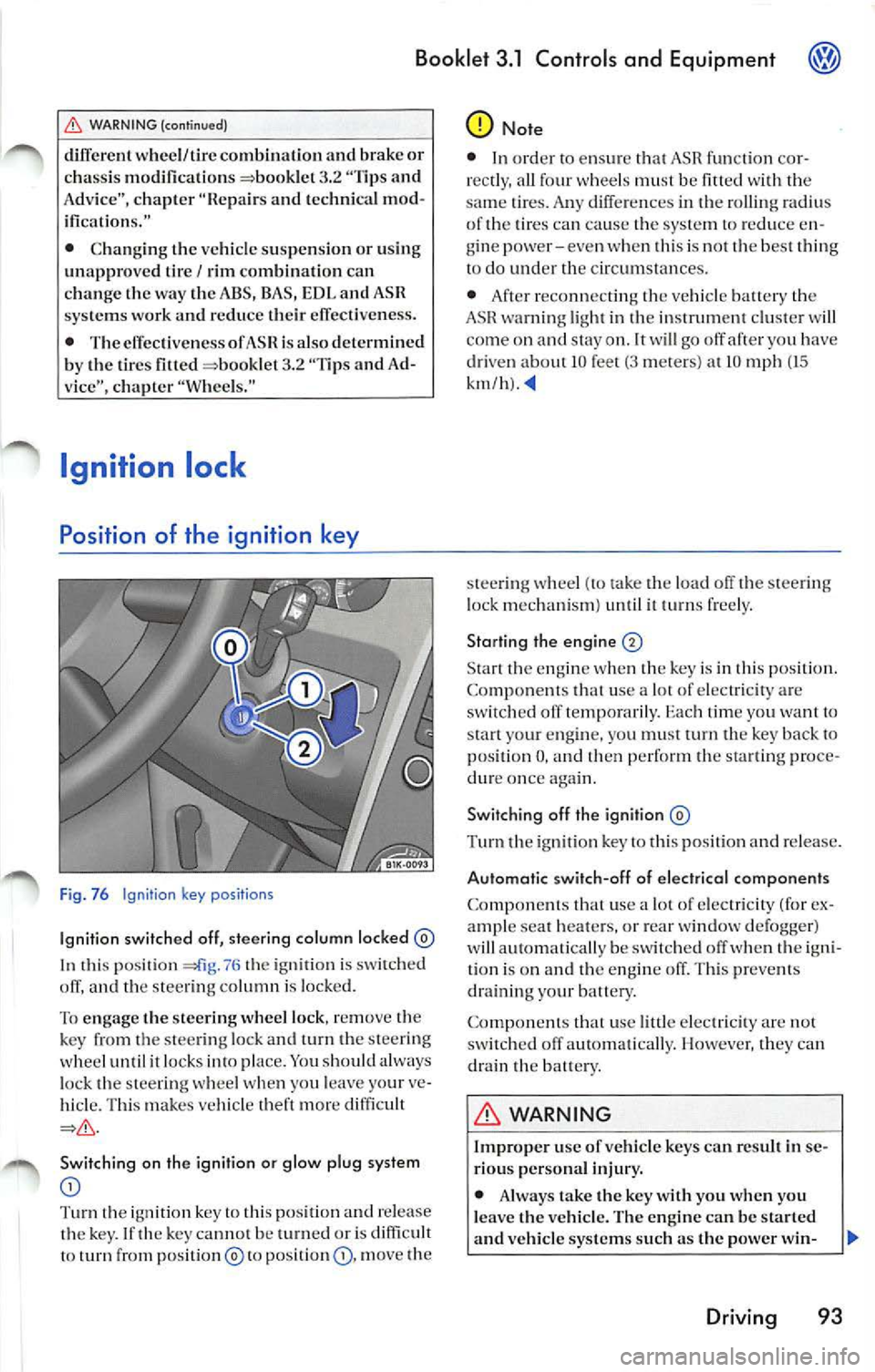
Booklet 3.1 Controls and Equipment
i0, WARNING (continued)
different wheel/lire combination and brake or
c ha ssis modifications 3.2 "Tips and
Advic e", chapt er "lle pair s and technical mod
ifications."
• Changing the vehicle suspens ion or using
unappro ved tire
I rim combination can
c h ange the way the ABS, BAS, EDL and ASH
sys tems work and redu ce their elTective ne ss.
• Th e effectivene ss of
is also determined
b y th e tir es 3.2 and Ad
v ic e", chapter "Wheels."
Ignition lock
Position of the ignition key
F ig . 76 lgnilion key posit io ns
Ignition switched off, steering column
In thi s po siti on the ig niti on is sw itched
off, and th e steering co lumn i s locked.
T o engage the stee ring wheel lock, re m ove the
key from the steering lo ck and turn the stee ring
w hee l un til it locks into place. You should always
l oc k the steer ing whee l w hen yo u le ave your ve
hicl e. This make s vehi cle th eft m ore difficult
Switching on the ignition or glow plug system
Turn the ig niti on key to this pos ition and re lease
th e key. If the key can not b e tu rned or is difficult
turn from pos ition ® to posi tion m ove the
go off afte r you have
d riven about IO fee t (3 meter s) at 10 mph (15 km/ h).
s tee ring wheel (to take the load off the stee ring
l ock mec han ism) until it turn s free ly.
Starting the engine
Start the en gin e when the key is in this posit io n.
Co mp onent s th at u se a lot of electricity are
sw itch ed olT te mp orar ily. Each time you want to
s tart your engine, you must turn the ke y back to
position
0, and then perform the starting proce
dure once aga in.
Switching off the ignition
Turn the ignition ke y this position and re lease.
Automatic switch-off of ele ctrical components
Comp on en ts that use a lo t of e lectricity (for ex
a mpl e se at heat ers, or rear win dow defogge r)
wi ll aut om aticall y be switc hed off wh en th e ign i
ti on is o n and th e eng ine off. This prevents
draining your b all ery.
Com po nent s th at us e littl e elec lricit y are not
sw itch ed off automatica lly. H oweve r, th ey ca n
drain the batt ery.
WARNING
Improp er u se of vehicl e ke ys can resu lt in se
rious personal injur y.
• Always take the key wit h yo u when you
le ave the vehicl e. The engine can be star ted
and vehicle systems s uch as the power win-
»,,
Driving 93
Page 308 of 477
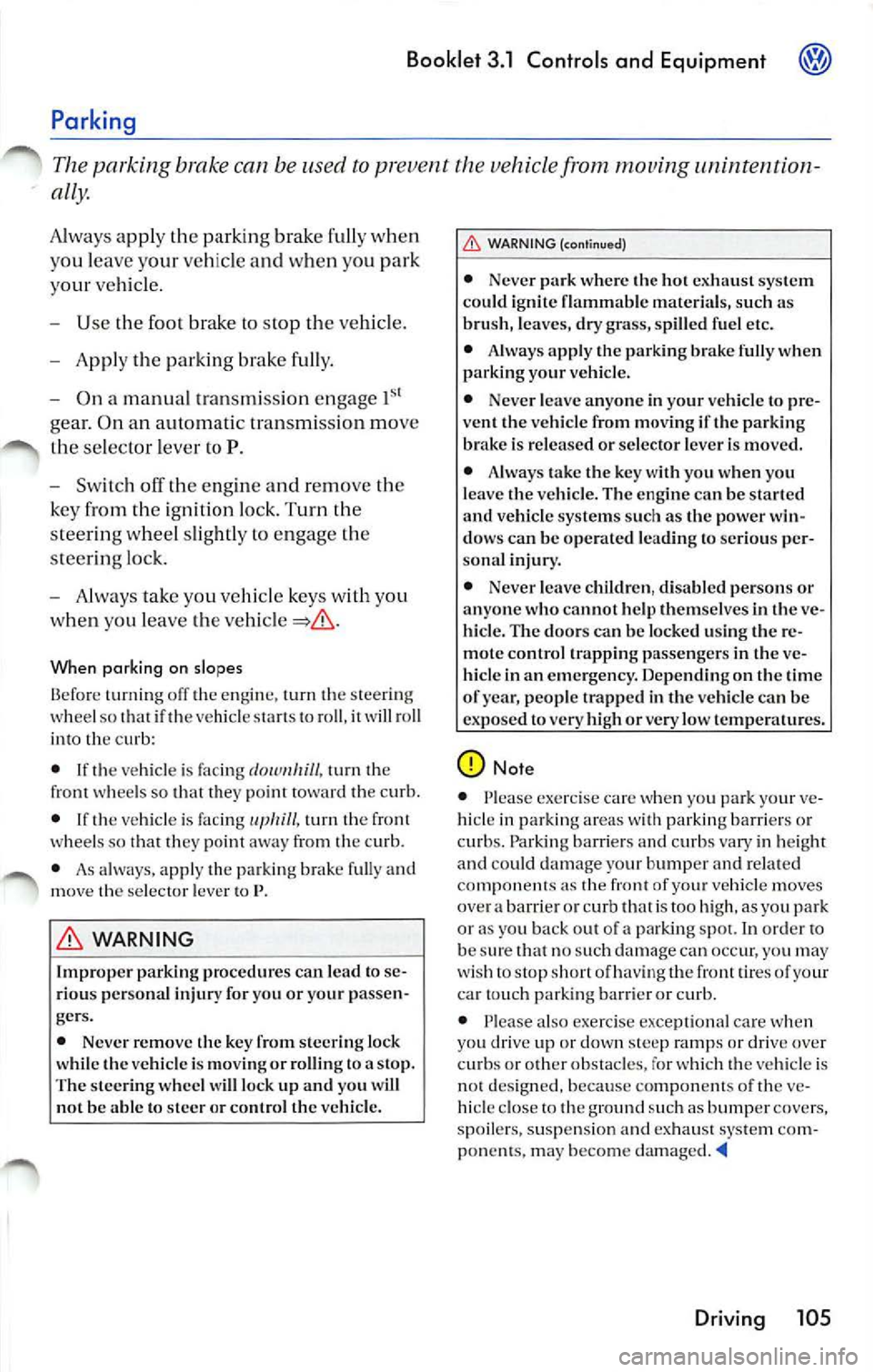
Booklet 3.1 Controls and Equipment
Parking
The parking brake can be us ed to pr eve nt the vehicle from moving uninten tion
ally.
A lways apply th e parking brake fully when
yo u leave y our vehicl e a nd when you p ark
yo ur vehicl e.
- Use the foo t brake to stop the veh icle.
- Appl y th e parking brake full y.
- On a ma nual tran smi ssion engage
gea r. On a n aut omatic tra nsmi ssion move
the selector lever to P.
- Switch off the engine and r emo ve the
key from the ignition lock. Turn th e
s tee rin g w he el s li ghtl y to en gage the
stee ring loc k.
- Always take you ve hicle keys w ith you
whe n yo u leave the
When parking on slopes
Before turnin g off the engin e, turn the steer ing
w hee l so if th e vehicle sta rt s to ro ll, it will roll
i nt o th e c urb:
• If th e ve hicle is faci ng
turn the whee ls so that they poilll toward the cur b.
• If th e vehicle is faci ng
turn the front
w heels so t hat they poi nt away from the curb .
• As a lways, appl y th e pa rking
full y and
m ove the se lector lever to P.
WARNING
Improp er parking procedures can lead to se
ri ous perso nal injury for you or your passen
gers.
• Never remove the key from steering lock
whil e th e ve hicle is movin g or rollin g to a stop .
The steer ing wheel
will lock up and you will not be able to stee r or control the vehicle.
WARNING
• Never park where the hot exha ust sys te m
co uld ignit e flammabl e material s, such as
bru sh, l eave s, dry grass, sp illed fuel etc.
• Alw ays apply the parking brak e fuJly wh en
parking your vehicle.
• Never leave anyone in your vehicl e to pre
ven t the ve hicle from moving if the parking
br ake is r elease d or selector lever is moved.
• Alwa ys tak e the key w ith you when you
l e ave the vehicle. The engine can be started
and vehicl e sy stems su ch as the power win
d ows can be operated leading to seriou s per
s onal injury .
• Never leave children , disabl ed p erson s or
anyone who cannot help th emselves in the ve
hicl e. The doors can b e lock ed u sing th e re
mot e co ntrol trappin g passenger s in the ve
hicle in an emergenc y. Depending on the time
of year, people tr app ed in
vehicle can be
expose d to v ery high or very low temperatures.
Note
• Please exercise care when yo u pa rk your ve
hicl e in parkin g are as w ith p arkin g barri ers or
cu rb s. Parking barriers and curb s vary in heig ht
an d co uld damage yo ur bump er and re la te d
compo nents as th e fron t of yo ur vehicl e moves
over
b arri er or curb that is too high . as you park
or as you back out of parking spot. In order to
be sur e th at no su ch d ama ge ca n occ ur, yo u m ay
wish to s top sh or t o f h av ing th e front tires o f yo ur
ca r touc h parking barri er o r curb.
• Please a lso exe rcise exce ptiona l ca re when
yo u drive up or d own steep ramp s or drive over
cu rbs or oth er obsta cles, fo r w hi ch lhe ve hicle is
not d esign ed , b ec au se compone nts of th e ve
hicl e close lo th e groun d su ch as bump er cove rs,
s poil ers , suspensio n and exhaust syste m com
ponent s, m ay beco me
Driving 105
Page 311 of 477

Booklet 3.1 Controls and Equ ipment
Accelerating
- Pull th e lever upward in direction
to th e+ position to increase the
s peed by about 0.5 mph
(I km/h ).
Decelerating
- Pull the lever downward in direction of
a rrow © to the - positio n to lowe r the
s peed b y 0.5 mph (about I km/h).
Switching off
-Push the leve r in the direction of arrow
all the way to the OFF position whil e
d rivi ng. The CHU ISE or
symbo l goes off .
- Sw itch th e ignit ion off when the v ehicle
i s standing still.
WARNING
Using the crui se cont ro l whe n it i s not possib le
to dri ve sa fely at a constant speed is dangerous
in "Desc ription".
Tip s
• If th e cruise con trol is switc hed on th e
( or ·t-i sy mbol in the in stru ment cluster
li g ht s up .
• If th e c ruise co ntrol i s
the or symb ol goes o ut. The syste m is
swi tc h ed off compl etely when the selec tor leve r
is in P, Nor
• If yo u increase vehicl e speed with th e accel
erato r pedal, the prev ious ly programmed sp eed
will be re sum ed when the acce le rator p edal is re
leased . T hi s w ill not be the case. however, ifche
vehicle s peed is mo re than 6 mph (10 km/h)
hi gh er than the s tored speed fo r long er
5
minut es. The speed will then have to be store d
again .
• The set speed can be sw itche d off te mpo
rarily if you p ress the brake peda l or the clutch
pedal. Pull th e lever briefly towa rd th e steering
whee l to the point where you can start to fee l re
s is tance
107, fig. 85 to r esum e the
speed again. "'4
App lies to vehic les: with independent lever for Cruise cont·ol
Turning off control temporarily
You can turn off the control temporar ily as
follow s:
- Depress the brake pedal,
- Dep re ss th e clutch pedal, or
- Pu sh the l ever briefly to the point where
yo u can star t to feel r esis tanc e in the dir ec
t ion of a rrow
10 7, 85
Th e set sp ee d re mains in th e mem ory , but it is
not maintain ed. To res um e the spee d previo usly
se lected, re lease the brak e pedal and pull th e
l e ver bri efly coward the stee ring wheel to the
108 Driving
point whe re yo u ca n start to f eel resi stan ce 107, fig. 85
If you drive faster than about 1 10 mph (180 km/h)
the cru ise co ntrol is sw itch ed off automati cally
a nd you cann ot ac tivate the cruise contro l. To
ac tivate the cru ise control again, drive s lower
than about 110 mph (180 km/ h).
WARNING
Us ing the cruise contro l when it is not possib le
to drive safely at a constant spee d is dangerous
in "Descrip tion" on page 107. "'4
Page 324 of 477
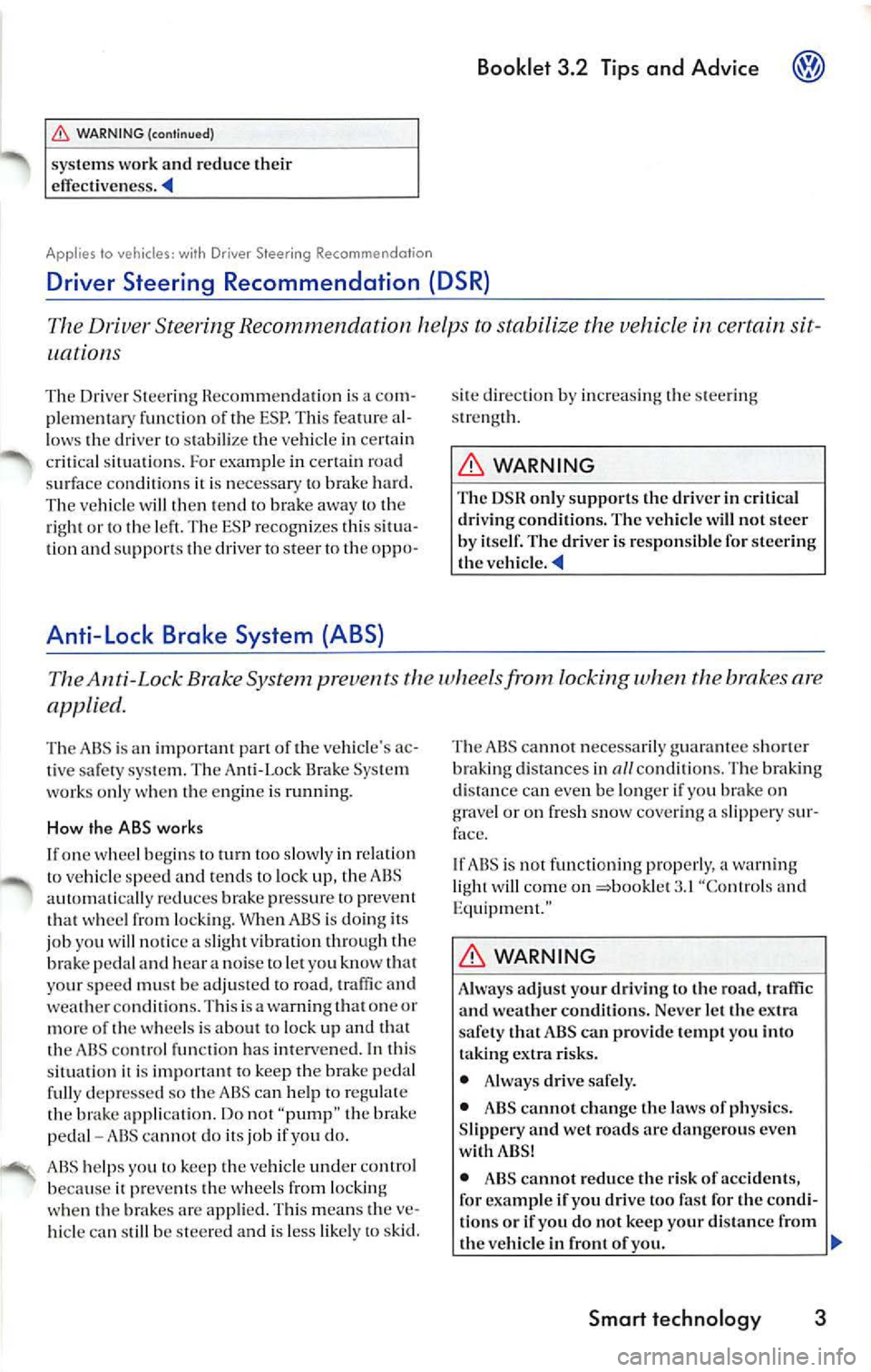
WARNING (continued)
systems work and reduce their
effect iveness.
Applies to vehicles: with Driver Steering Recommenda tion
Booklet 3 .2 Tips and Advice
Driver Steering Recommendation helps to the vehicle in certain sit
uations
The Driver Stee ring R ecomm endation i s a com
pl em entar y function of the ESP. This fea ture al
low s th e driv er
stabilize ve hicl e in certain
critical situati ons. Fo r example in certai n road
s ur face conditi ons ii is necessary to brake hard.
The vehicl e will then te nd to brak e awa y to the
r ig ht or t o 1h e lef t. Th e ESP reco gnizes this situ a
tion and supp ort s the drive r to steer to the oppo-
Anti -Lock Brake System {ABS)
sit e dire cti on by in crea sing th e stee rin g
s tr ength.
WARNING
The DSH only supports the driver in cri tical
dri vin g co ndition s. The ve hicl e will not s teer
by itse lf. The dr ive r is res pon sible fo r steering
the vehicle .
The Anti-Lock Brake System prevent s th e wheels from locking when the brakes are
applied.
Th e ABS is an important part of the vehicle 's ac
ti ve safety system. The Anti-Lo ck Brake Syste m
work s onl y when the en gine is run ning.
How the ABS works
If one w he el begi ns tu t urn too s low ly in r elat io n
t o ve hicl e speed an d le n ds to lock up, t he ABS
a utom ati ca ll y
brak e pres sur e lO preve nt
that whee l fr om locking. When ABS is do ing it s
job you will notice a sli ght vibrati on throu gh the
brake pedal and hea r a noise to l et yo u know tha t
yo ur speed must be adjuste d to road, traffic and
wea ther condi tion s. T his is a warn ing 1hat on e or
mor e of the whee ls is about to lock up and that
th e AB S co ntr ol function has inter vened . In thi s
s ituati on
is important to keep the brak e peda l
fully depr essed so the ABS can help to re gul ate
th e brake applica tion. Do not "pump " th e
peda l -ABS can not do its jo b if you do.
A BS helps you 10 kee p th e ve hicl e und er control
be cause i t prev ent s th e w hee ls from locking
w hen th e brak es arc ap plied. Th is m ean s th e ve
hicl e ca n still be s teer ed and is less likely
on
g rav el o r on fresh sno w cover in g a slipp ery sur
If AB S is not functioning properl y, a wa rnin g
li ght will co me on 3.1 "Co n1rol s and
E quipm ent. "
WARNING
Always ad just yo ur dri vin g to the road, traffic
and weather conditio ns. Neve r le t th e ex tra
s afe ty that ABS can provide te mpt you into
taking extra risks.
• Always drive safely .
• ABS canno t ch ange the
of ph ysics.
S lipp ery and wet roads are dangerou s ev en
wi th ABS!
• ABS ca nnot reduce th e risk of accide nts,
f or examp le if yo u drive too
for the co ndi
ti ons or if you do not keep your distance from
th e vehicle in front of you.
Smart technology 3